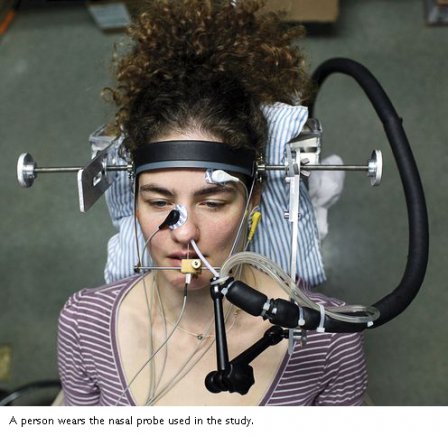Hot spots aid brain, “exciting, disturbing” study hints.

Millions of receptors in the nose’s smelling organ aren’t scattered at random, a new study says. Instead, the receptors congregate in tiny hot spots that help the brain discern good smells from bad ones, among other potential functions.
The evidence was gathered by sticking electronic probes up people’s noses and measuring the chatter of nasal neurons as subjects were exposed to scents.
The findings imply that the pleasantness of a smell is hardwired within our heads, calling into question the impact of life experience on how people perceive smells.
“It’s both exciting and disturbing,” said Don Wilson of the New York University School of Medicine, a neurobiologist who was not involved in the work.
“It doesn’t fit in with what I think or a lot of other researchers think about smell.”
Instead of the brain processing all scent information, for instance, it seems nasal neurons preprocess some of it—almost as if the nose has its own small brain.
Taking One in the Nose
The human nose contains a postage stamp-size smelling organ, called the olfactory epithelium, at the roof of the nasal cavity.
By probing mouse noses to measure the firing of nasal neurons, scientists had previously discovered that scent receptors might be organized into groups, similar to the way the tongue has zones armed to detect specific tastes such as sour, sweet, and salty.
But a rodent’s nose has more than 1,200 different types of scent receptors, and even a tiny probe could touch tens of thousands of receptors in one reading, making it hard to get a clear signal.
Humans have roughly 400 different kinds of receptors, however, making the business of sticking probes in noses and plucking out useful information more fruitful.
How the Nose Knows
A team led by neuroscientist Noam Sobel, of the Weizmann Institute of Science in Israel, asked more than 80 people to sniff substances with odors known to be either pleasant or unpleasant across many cultures.
Ordinary smells can be made up of tens to hundreds of compounds, so Sobel and his colleagues puffed only pure chemicals into the noses of their wired subjects, one scent at a time.
Pooling together 801 neural recordings from people’s noses, the team found that some regions of the epithelium are better at detecting scent than other regions.
The researchers also found hot spots that are better at interpreting either pleasantness or unpleasantness.
“To my surprise, this means something about the epithelium is tuned to pick up certain information” in certain zones, New York University’s Wilson said.
“We don’t understand what the purposes of those zones are,” he added, “but that’s exciting.”
The smelling study was published online last week in the journal Nature Neuroscience.
Click here for article link.
